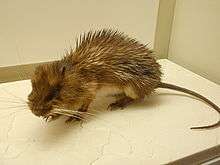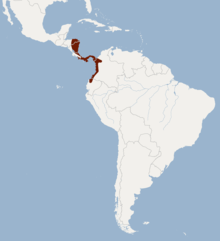Armored rat
| Armored rat | |
|---|---|
 | |
| Scientific classification | |
| Kingdom: | Animalia |
| Phylum: | Chordata |
| Class: | Mammalia |
| Order: | Rodentia |
| Family: | Echimyidae |
| Subfamily: | Echimyinae |
| Tribe: | Myocastorini |
| Genus: | Hoplomys J. A. Allen, 1908 |
| Species: | H. gymnurus |
| Binomial name | |
| Hoplomys gymnurus (Thomas, 1897) | |
 | |
| Distribution of the armored rat | |
The armored rat (Hoplomys gymnurus) is a species of rodent in the family Echimyidae. It is monotypic within the genus Hoplomys.[2] It is found in Latin America, from northern Honduras to northwest Ecuador. It possesses a range of spines on its back and sides of the body.[3]
Description
Adults weigh between 218–790 grams (0.481–1.742 lb) with males weighing more on average than females. They are born with soft fur, and the spines begin growing after the first month. The thick spines on the back and sides measure up to 33 millimetres (1.3 in) and 2 millimetres (0.079 in) in diameter.[4] The head and body measures between 220–320 millimetres (8.7–12.6 in) in length, with the tail adding another 150–255 millimetres (5.9–10.0 in).[4] The color of the armored rat range from black to reddish brown, and has a pure white underside. They are similar in appearance to Tome's spiny-rat, but the eyes of the armored rat are smaller and they have a longer snout.[3] Its diet includes fruit, insects and green plant matter. The normal litter size is one to three, and the fur on the offspring is soft with the spines only developing after the first month.[3]
Habitat
The armored rat is nocturnal species, which occupies burrows. These burrows are usually positioned in steep banks close to a water source, and can measure up to 2 metres (6.6 ft) in length before reaching a nesting chamber.[3] They are distributed from northern Honduras to northwest Ecuador, from lowlands up to around 800 metres (2,600 ft) in altitude.[3]
Etymology
- The genus name Hoplomys derives from the two Ancient Greek words ὅπλον (hóplon), meaning "armor", and μῦς (mûs), meaning "rat".[5][6]
- The species name gymnurus derives from the two Ancient Greek words γυμνός (gumnós), meaning "naked", and οὐρά (ourá), meaning "tail".
Phylogeny
Part of the infraorder Hystricognathi and family Echimyidae, armored rats are more closely related to porcupines, Guinea pigs, chinchillas, and common degus than to the common brown rat.[7][8]
Within Echimyidae, the genus Hoplomys is the sister group to the genus Proechimys. In turn, these two taxa share evolutionary affinities with other Myocastorini genera: Callistomys (painted tree-rats) and Myocastor (coypus or nutrias) on the one hand, and Thrichomys on the other hand.
| Genus-level cladogram of the Myocastorini. | ||||||||||||||||||||||||
|
| ||||||||||||||||||||||||
| The cladogram has been reconstructed from mitochondrial and nuclear DNA characters.[9][10][11][12][13][14][15] |
References
- Specific
- ↑ Gómez-Laverde, M.; Anderson, R. P.; Emmons, L. & Samudio, R. (2008). "Hoplomys gymnurus". IUCN Red List of Threatened Species. Version 2008. International Union for Conservation of Nature. Retrieved 5 January 2009.
- ↑ Woods, C.A.; Kilpatrick, C.W. (2005). "Infraorder Hystricognathi". In Wilson, D.E.; Reeder, D.M. Mammal Species of the World: A Taxonomic and Geographic Reference (3rd ed.). Johns Hopkins University Press. p. 1583. ISBN 978-0-8018-8221-0. OCLC 62265494.
- 1 2 3 4 5 Reid, Fiona (1997). A Field Guide to the Mammals of Central America & Southeast Mexico. New York: Oxford University Press. pp. 251–252.
- 1 2 Nowak, Ronald M (1999). Walker's Mammals of the World. Baltimore: Johns Hopkins University Press. p. 1689. ISBN 978-0-8018-5789-8.
- ↑ Bailly, Anatole (1981-01-01). Abrégé du dictionnaire grec français. Paris: Hachette. ISBN 2010035283. OCLC 461974285.
- ↑ Bailly, Anatole. "Greek-french dictionary online". www.tabularium.be. Retrieved 2017-01-24.
- ↑ Huchon, Dorothée; Douzery, Emmanuel J.P. "From the Old World to the New World: A Molecular Chronicle of the Phylogeny and Biogeography of Hystricognath Rodents". Molecular Phylogenetics and Evolution. 20 (2): 238–251. doi:10.1006/mpev.2001.0961.
- ↑ Reid, Fiona (2010). The Wildlife of Costa Rica. Ithaca, N.Y.: Comstock Pub. Associates. p. 17. ISBN 978-0-8014-7610-5.
- ↑ Galewski, Thomas; Mauffrey, Jean-François; Leite, Yuri L. R.; Patton, James L.; Douzery, Emmanuel J. P. (2005). "Ecomorphological diversification among South American spiny rats (Rodentia; Echimyidae): a phylogenetic and chronological approach". Molecular Phylogenetics and Evolution. 34 (3): 601–615. doi:10.1016/j.ympev.2004.11.015.
- ↑ Upham, Nathan S.; Patterson, Bruce D. (2012). "Diversification and biogeography of the Neotropical caviomorph lineage Octodontoidea (Rodentia: Hystricognathi)". Molecular Phylogenetics and Evolution. 63 (2): 417–429. doi:10.1016/j.ympev.2012.01.020.
- ↑ Fabre, Pierre-Henri; Galewski, Thomas; Tilak, Marie-ka; Douzery, Emmanuel J. P. (2013-03-01). "Diversification of South American spiny rats (Echimyidae): a multigene phylogenetic approach". Zoologica Scripta. 42 (2): 117–134. doi:10.1111/j.1463-6409.2012.00572.x. ISSN 1463-6409.
- ↑ Loss, Ana; Moura, Raquel T.; Leite, Yuri L. R. (2014). "Unexpected phylogenetic relationships of the painted tree rat Callistomys pictus (Rodentia: Echimyidae)" (PDF). Natureza on line. 12: 132–136.
- ↑ Fabre, Pierre-Henri; Vilstrup, Julia T.; Raghavan, Maanasa; Der Sarkissian, Clio; Willerslev, Eske; Douzery, Emmanuel J. P.; Orlando, Ludovic (2014-07-01). "Rodents of the Caribbean: origin and diversification of hutias unravelled by next-generation museomics". Biology Letters. 10 (7): 20140266. doi:10.1098/rsbl.2014.0266. ISSN 1744-9561. PMC 4126619.
- ↑ Upham, Nathan S.; Patterson, Bruce D. (2015). "Evolution of Caviomorph rodents: a complete phylogeny and timetree for living genera". In Vassallo, Aldo Ivan; Antenucci, Daniel. Biology of caviomorph rodents: diversity and evolution. Buenos Aires: SAREM Series A, Mammalogical Research — Sociedad Argentina para el Estudio de los Mamíferos. pp. 63–120.
- ↑ Fabre, Pierre-Henri; Upham, Nathan S.; Emmons, Louise H.; Justy, Fabienne; Leite, Yuri L. R.; Loss, Ana Carolina; Orlando, Ludovic; Tilak, Marie-Ka; Patterson, Bruce D.; Douzery, Emmanuel J. P. (2017-03-01). "Mitogenomic Phylogeny, Diversification, and Biogeography of South American Spiny Rats". Molecular Biology and Evolution. 34 (3): 613–633. doi:10.1093/molbev/msw261. ISSN 0737-4038.
- General
- Woods, C. A. and C. W. Kilpatrick. 2005. Hystricognathi. pp 1538–1600 in Mammal Species of the World a Taxonomic and Geographic Reference 3rd ed. D. E. Wilson and D. M. Reeder eds. Smithsonian Institution Press, Washington D.C.
External links
| Wikimedia Commons has media related to Hoplomys gymnurus. |
